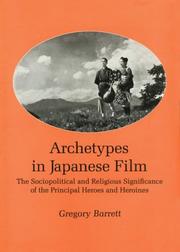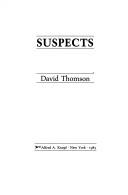| Listing 1 - 10 of 50 | << page >> |
Sort by
|
Book
ISBN: 9780367660369 9781138391826 0429422504 9780429422508 9780429749179 0429749171 9780429749155 0429749155 9780429749162 0429749163 Year: 2020 Publisher: London ; New York : Routledge,
Abstract | Keywords | Export | Availability | Bookmark
 Loading...
Loading...Choose an application
- Reference Manager
- EndNote
- RefWorks (Direct export to RefWorks)
Characters are central to our experiences of screened fictions and invite a host of questions. The contributors to Screening Characters draw on archival material, interviews, philosophical inquiry, and conceptual analysis in order to give new, thought-provoking answers to these queries. Providing multifaceted accounts of the nature of screen characters, contributions are organized around a series of important subjects, including issues of class, race, ethics, and generic types as they are encountered in moving image media. These topics, in turn, are personified by such memorable figures as Cary Grant, Jon Hamm, Audrey Hepburn, and Seul-gi Kim, in addition to avatars, online personalities, animated characters, and the ensembles of shows such as The Sopranos, Mad Men, and Breaking Bad "This book gives an account of characterization in moving image fictions. Areas of investigation include the importance of performer and stars, the societal contexts of types, the constraints of the medium, the role of a specific genre and the question of emotional and moral engagement"--

ISBN: 0941664937 Year: 1989 Publisher: Selinsgrove : Susquehanna university press,
Abstract | Keywords | Export | Availability | Bookmark
 Loading...
Loading...Choose an application
- Reference Manager
- EndNote
- RefWorks (Direct export to RefWorks)
Book
Year: 1980 Publisher: [Paris] : Gallimard,
Abstract | Keywords | Export | Availability | Bookmark
 Loading...
Loading...Choose an application
- Reference Manager
- EndNote
- RefWorks (Direct export to RefWorks)
Book
ISBN: 9781839024818 9781839024825 Year: 2023 Publisher: London : BFI,
Abstract | Keywords | Export | Availability | Bookmark
 Loading...
Loading...Choose an application
- Reference Manager
- EndNote
- RefWorks (Direct export to RefWorks)
This book seeks to reshape the way that writers think about constructing their story, looking at the subject from the inside out. Often practitioners and theorists examine work through the separate lenses of character and/or structure and then bring them together. Within this book, authors Hughes and Wilkes argue that character is structure and one without the other makes for a dissatisfying narrative.Through detailed case studies on films that span all genres, from mainstream franchises like The Hunger Games (2012-2015) and Shrek (2001-2010) to art house films such as Toto Le Heros (1991) and Eraserhead (1977), the authors reveal the dramatic imperative behind the central choices or dilemmas faced by every protagonist in every classic feature length narrative. They argue there is only one of five choices that any writer must make in inventing that key transition from the protagonist's ordinary world into the adventure that will form the heart of their story.Using the universal language of folk and fairy stories, this book gives writers and students a clear framework through which they can reference and improve their own storytelling. In doing so, it enables both the novice and experienced screenwriter to tell their story in the most authentic and impactful way, while keeping their protagonist at the heart of the narrative.
Book
ISBN: 2200634439 Year: 2022 Publisher: Malakoff : Dunod Editeur,
Abstract | Keywords | Export | Availability | Bookmark
 Loading...
Loading...Choose an application
- Reference Manager
- EndNote
- RefWorks (Direct export to RefWorks)
Que retenons-nous d'un film ? Quels sont les souvenirs qui survivent des mois ou des années après avoir vibré devant les images, les mots, l'histoire, la musique, et tout ce qui forge une oeuvre cinématographique ? Des scènes emblématiques, cela est certain. Souvent des moments d'émotion intense. Parfois l'ingéniosité du récit. Dans une certaine mesure le dépaysement ou au contraire l'étonnante proximité qu'offre le contexte narratif ... Mais surtout des personnages que, dans le meilleur des cas, l'on n'oubliera jamais.0Comment parvenir à en créer de suffisamment puissants pour que les spectateurs s'y attachent au plus vite ? Pour qu'ils en comprennent les moteurs internes ? Non pas forcément qu'ils les aiment et encore moins qu'ils veuillent lui ressembler, mais qu'ils soient passionnés par le spectacle de leurs actions ?0C'est à l'approche de cette tâche assez délicate et, disons-le clairement, mystérieuse que cet ouvrage est consacré. Vous trouverez là des méthodes pour démarrer de la page blanche, des approches pour concevoir chaque individu, afin d'enrichir une psychologie, de rendre un personnage attachant ou répugnant, d'amener le public à entrer dans le personnage pour mieux vivre l'histoire avec lui.

ISBN: 0394542266 9780394542263 Year: 1985 Publisher: New York Alfred A. Knopf
Abstract | Keywords | Export | Availability | Bookmark
 Loading...
Loading...Choose an application
- Reference Manager
- EndNote
- RefWorks (Direct export to RefWorks)
Noah Cross, Norma Desmond, Norman Bates, Harry Lime--these are a few of nearly 100 names that inhabit the mind of the narrator as he starts to compose short biographies of some of the most famous characters in the history of film noir. He sketches in whole lives, lives as intense as the dreams put up on the screen. The book begins to become a novel when the characters start to meet each other outside their respective films--as if they were real people with needs and passions. The names and faces are familiar to us--Jake Gittes from Chinatown,Laura Hunt and Waldo Lydecker from Laura, Rick and Ilsa from Casablanca--but is it true that Noah Cross and Norma Desmond were lovers in the 1920s, that she and Joe Gillis had a son who grew up to be Julian Kay in American Gigolo? The narrator is not merely the author, he has a mission to carry out--a lost family link to find, a thread to pull so that nearly all these disparate characters come together to form a kind of society. Ultimately this examination on how movies affect audiences--not only shaping perceptions and memories, but in some ways coming to stand in for them--can also be read as an unsettling examination of identity and the construction of self through the medium of narratives;or simply as a fascinating take on movie fandom.
Motion pictures --- Characters and characteristics in motion pictures --- Film noir
Book
ISBN: 9788370724511 Year: 2007 Publisher: Warszawa Wydawnictwo Uniwersytetu Kardynała Stefana Wyszyńskiego
Abstract | Keywords | Export | Availability | Bookmark
 Loading...
Loading...Choose an application
- Reference Manager
- EndNote
- RefWorks (Direct export to RefWorks)
Book
ISBN: 9781501361241 9781501361210 9781501361234 9781501361227 Year: 2024 Publisher: New York, N.Y. Bloomsbury Academic
Abstract | Keywords | Export | Availability | Bookmark
 Loading...
Loading...Choose an application
- Reference Manager
- EndNote
- RefWorks (Direct export to RefWorks)
"Develops a program for undertaking figural analysis of narrative film by drawing on the work of three philosophers: Walter Benjamin, Jacques Lacan and Gilles Deleuze"-- Employing theoretical concepts drawn from a range of sources, including French post-humanist philosophy and German Idealism, the book undertakes an organology of film guided by the work of Bernard Stiegler whose philosophy of mnemotechnesis provides the framework of analysis. Situating films in the quantum field of spacetime relativity as a field of cosmic views, inquiry into film figures begins with disturbances in the experience of films themselves, posing questions of the relation between the dead past and the living future in film story-telling. By breaking the façade of the continuing present through self-questioning, we open films to their figural dimensions in the counter-movement of drive as negentropic resistance. Following the back-movement of drive switches our perception to the figural register in which characters become figures probing blindly for what the film will have been in another time – a time yet to be lived. By following the anterior possibilities of this other time, we open films to the archival future in which a new future comes forth.This book provides theoretical and analytical concepts as well as strategies for taking a step into this future, guided by questions of the right path to take given the relativity of views in which the film can be experienced. Films analysed include Murnau's The Last Laugh, Capra's It's a Wonderful Life, Hitchcock's Rear Window, Welles's The Lady from Shanghai, Fellini's Intervista, Antonioni's L'Eclisse, Bresson's Une Femme Douce, and Zeller's The Father.
Motion pictures --- Characters and characteristics in motion pictures. --- Philosophy. --- Film
Book
ISBN: 9780198871071 0198871074 Year: 2022 Publisher: Oxford : Oxford University Press,
Abstract | Keywords | Export | Availability | Bookmark
 Loading...
Loading...Choose an application
- Reference Manager
- EndNote
- RefWorks (Direct export to RefWorks)
Characters - those fictional agents populating the fictional worlds we spend so much time absorbed in - are ubiquitous in our lives. We track their fortunes, judge their actions, and respond to them with anger, amusement, and affection - indeed the whole palette of human emotions. Powerfully drawn characters transcend their stories, entering into our imaginations and deliberations about the actual world, acting as analogies and points of reference. And yet there has been remarkably little sustained and systematic reflection on these creatures that absorb so much of our attention and emotional lives.In Engaging Characters, Murray Smith sets out a comprehensive analysis of character, exploring the role of characters in our experience of narrative and fiction. Smith's analysis focuses on film, and also illuminates character in literature, opera, song, cartoons, new and social media. At the heart of this account is an explanation of the capacity of characters to move us. Teasing out the various dimensions of character, Smith explores the means by which films draw us close to characters, or hold us at a distance from them, and how our beliefs and attitudes are formed and sometimes reformed by these encounters. Integrating these arguments with research on emotion in philosophy, psychology, evolutionary theory, and anthropology, Engaging Characters advances an account of the nature of fictional characters and their functions in fiction, imagination, and human experience.In this revised, twenty-fifth anniversary edition of Engaging Characters, Smith refines and extends the arguments of the first edition, with a substantial new introduction reviewing the debates on emotion, empathy, and film spectatorship that the book has inspired.
Book
ISBN: 2859470980 9782859470982 Year: 2001 Publisher: Paris : Dujarric,
Abstract | Keywords | Export | Availability | Bookmark
 Loading...
Loading...Choose an application
- Reference Manager
- EndNote
- RefWorks (Direct export to RefWorks)
| Listing 1 - 10 of 50 | << page >> |
Sort by
|

 Search
Search Feedback
Feedback About UniCat
About UniCat  Help
Help News
News